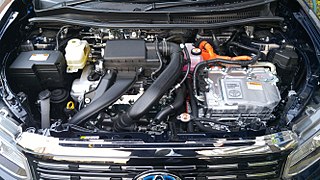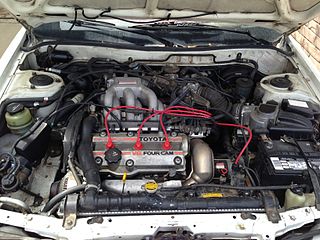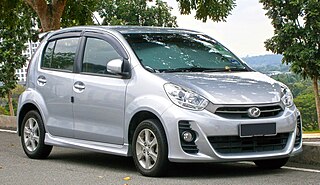
The Toyota Vitz is a subcompact car produced by the Japanese automobile manufacturer Toyota from 1999 to 2019 in a three- or five-door hatchback body styles. The "Vitz" nameplate was used consistently in Japan, while most international markets received the same vehicle as the Toyota Yaris, or as the Toyota Echo in some markets for the first generation. The Vitz was available in Japan from Toyota's Netz Store dealerships. Toyota began production in Japan and later assembled the vehicle in other Asian countries and in France.

The Toyota A Series engines are a family of inline-four internal combustion engines with displacement from 1.3 L to 1.8 L produced by Toyota Motor Corporation. The series has cast iron engine blocks and aluminum cylinder heads. To make the engine as short as possible, the cylinders are siamesed.

The Daihatsu Terios is a mini SUV produced by the Japanese automobile manufacturer Daihatsu since 1997 as the successor to the F300 series Rocky. It was initially offered in both short- and long-wheelbase configurations before the former stopped production in 2016 to be replaced by the A200 series Rocky crossover in 2019. The long-wheelbase variant is available mainly for the Indonesian market with three-row seating options. A smaller kei car model called the Terios Kid/Lucia was also available for the first-generation model.

The Toyota JZ engine family is a series of inline-6 automobile engines produced by Toyota Motor Corporation. As a replacement for the M-series inline-6 engines, the JZ engines were 24-valve DOHC engines in 2.5- and 3.0-litre versions.

The Toyota NZ engine family is a straight-4 piston engine series. The 1NZ series uses aluminum engine blocks and DOHC cylinder heads. It also uses sequential fuel injection, and has 4 valves per cylinder with VVT-i.

The Toyota ZZ engine family is a straight-4 piston engine series. The ZZ series uses a die-cast aluminium engine block with thin press-fit cast iron cylinder liners, and aluminium DOHC 4-valve cylinder heads. The camshafts are chain-driven. The two 1.8 L members of the family, the 1ZZ and 2ZZ, use different bore and stroke. The former was optimised for economy, with torque emphasised in lower revolutions per minute operating range, while the latter is a "square" design optimised for high-RPM torque, yielding higher peak power. The ZZ family replaced the extremely popular cast-iron block 4A engines.

The Toyota AZ engine family is a straight-4 piston engine series. The AZ series uses an aluminium engine block with cast iron cylinder liners and aluminium DOHC cylinder head. The engine series features many advanced technologies including slant-squish combustion chambers, offset cylinder and crank centers, and the VVT-i continuously variable intake valve timing system. The aluminium engine measures 626 mm (24.6 in) long, 608 mm (23.9 in) wide, and 681 mm (26.8 in) tall.

The Toyota VZ engine family is a series of V6 gasoline piston engines ranging from 2.0 to 3.4 L in displacement and both SOHC and DOHC configurations. It was Toyota's first V6 engine, being made as a response to Nissan’s VG engine, one of Japan’s first mass-produced V6 engines.

The Toyota UZ engine family is a gasoline fueled 32-valve quad-camshaft V8 piston engine series used in Toyota's luxury offerings and sport utility vehicles. Three variants have been produced: the 1UZ-FE, 2UZ-FE, and 3UZ-FE. Production spanned 24 years, from 1989 to mid 2013, ending with the final production of the 3UZ-FE-powered Toyota Crown Majesta I-FOUR. Toyota's UZ engine family was replaced by the UR engine family.

The Toyota K series is an inline-four engine that was produced from 1966 through 2007. It is a two-valve pushrod engine design. It was originally built from the Toyota Kamigo plant in Toyota City factory in Japan.

The Perodua Myvi is a subcompact car/supermini (B-segment) produced by the Malaysian manufacturer Perodua since 2005. Based on the Daihatsu Boon, the Myvi is the result of Perodua's collaboration with both Toyota and Daihatsu. However, the third generation Myvi was entirely designed and made in Malaysia, thus not being based on the third generation Boon. The Myvi was the best-selling car in Malaysia for nine consecutive years, between 2006 and 2014, and again between the years 2018 and 2022. The Myvi has been Malaysia's best-selling car for 14 years since its first full year of sales in 2006. As of 2023, the Myvi reached 1.4 million units sold since the launch of its first generation in 2005.

The Toyota KR engine family is a straight-3 piston engine, designed by Daihatsu, a subsidiary of Toyota. The 1KR series uses aluminium engine blocks and chain driven DOHC cylinder heads. It uses multi-point fuel injection, and has 4 valves per cylinder. Some versions have VVT-i variable valve timing. The engine is exceptionally light: 69 kg (152 lb) with all ancillaries.

The Toyota UR engine family is a 32-valve dual overhead camshaft V8 piston engine series which was first introduced in 2006, as the UZ series it replaced began phasing out. Production started with the 1UR-FSE engine with D-4S direct injection for the 2007 Lexus LS. The series launched with a die-cast aluminum engine block, aluminum cylinder heads and magnesium cylinder head covers. All UR engines feature variable valve timing for both intake and exhaust cams or Dual VVT-i. Timing chains are used to drive the camshafts. The UR engine has been produced in 4.6, 5.0, and 5.7-liter displacement versions.

The Toyota Vios is a nameplate used for subcompact cars produced by the Japanese manufacturer Toyota, primarily for markets in Southeast Asia, China and Taiwan since 2002. Slotted below the compact Corolla, the Vios serves as the replacement to the Tercel, which filled the subcompact or B-segment sedan class in the region. It is also successor to the entry-level variants of the E110 series Corolla in some markets such as the Philippines and Vietnam.

The Toyota TR engine is a family of gasoline engines that appeared in 2004. They are mainly used for Toyota Hilux and other vehicles in the Toyota IMV platform; and are designed to be mounted longitudinally for pickup RWD and 4WD pickup applications.

The ZR engine is a family of straight-four 16-valve all-aluminum and water cooled gasoline engines with a die-cast aluminum block and variable valve timing developed by Toyota Motor Corporation, produced from 2007. Engines displace from 1.6 to 2.0 liters. Most engines in this family are equipped with Toyota's dual VVT-i technology that optimizes both intake and exhaust valve timing. This engine family is also the first to use Toyota's Valvematic system, first appearing on the Noah and Voxy in 2007 and then the European Avensis in 2009.

The AR engine family is an Inline-4 piston engine series by Toyota, first introduced in 2008 for the RAV4, and subsequently for the Highlander, Venza, Camry and Scion tC.

The Toyota NR engine family is a series of small inline-four piston engines designed and manufactured by Toyota, with capacities between 1.2 and 1.5 litres.
The Daihatsu H-series engine is a range of four-stroke four-cylinder, internal combustion piston engines, designed by Daihatsu, which is a subsidiary of Toyota. These engines were produced from 1987 through 2009. Ranging from 1.3 L up to 1.6 L, these four-cylinder engines were built with lightness in mind, featuring a hollow crankshaft and camshaft, and the weight of a four-cylinder engine is similar to the 1.0 L three-cylinder CB engines. The H-series engine has aluminium engine blocks and cylinder heads, timing belt driven heads, water-cooled engine cooling system, equipped with both carburetors and Multi-Point Fuel Injection and only available in 16-valve SOHC design.



















